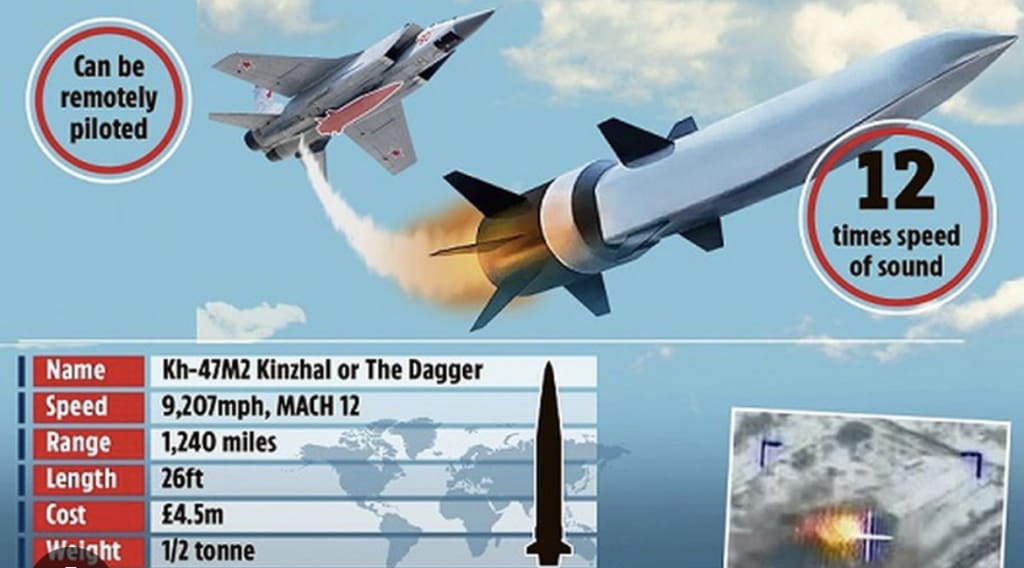Kinzhal
Kinzhal explanation

Kinzhal is a Russian hypersonic missile system that was developed in response to the United States' development of missile defense systems. The word "Kinzhal" means "dagger" in Russian.
The Kinzhal missile is carried by the Russian Air Force's MiG-31K interceptor aircraft. It is a nuclear-capable, air-launched ballistic missile that is capable of reaching speeds of up to Mach 10, or 7,600 miles per hour. This makes it virtually impossible to intercept by any existing missile defense system.
The missile has a range of over 1,200 miles and can carry a variety of payloads, including conventional or nuclear warheads. It is designed to be used against ground targets, such as military installations or ships, as well as against enemy aircraft and missile defense systems.
The Kinzhal missile system was first publicly revealed by Russian President Vladimir Putin in his state-of-the-nation address in March 2018. At the time, Putin boasted that the missile was "invincible" and could penetrate any existing or future missile defense system.
The development of the Kinzhal missile system is part of Russia's ongoing efforts to modernize its military and maintain a strategic advantage over its rivals. It is also seen as a response to the United States' efforts to develop missile defense systems, which Russia views as a threat to its national security.
While the Kinzhal missile system has been hailed as a technological breakthrough by the Russian military, it has also drawn criticism from some experts, who question its practicality and effectiveness. Some analysts have suggested that the missile may be too expensive and difficult to maintain, and that its limited range may make it less useful in many real-world scenarios.
Despite these concerns, the Kinzhal missile system remains a key component of Russia's military strategy, and it is likely to continue to play an important role in the country's defense capabilities for years to come.
In addition to its military capabilities, the Kinzhal missile system has also had important geopolitical implications. Its development and deployment have been seen as a significant challenge to the United States' global military dominance, and have contributed to an increased sense of tension and competition between the two countries.
The deployment of the Kinzhal missile system has also raised concerns about arms control and the risk of a new arms race. Some experts have suggested that the development of hypersonic missiles could lead to a destabilizing arms race between major powers, as each seeks to develop and deploy its own hypersonic capabilities.
Despite these concerns, the Kinzhal missile system has continued to be a major priority for the Russian military. In recent years, Russia has continued to test and refine the system, and has reportedly begun deploying it to certain military units.
The development of the Kinzhal missile system is just one example of the ongoing technological competition between major powers, as each seeks to develop new capabilities and gain an advantage over its rivals. As this competition continues, it is likely that we will see further developments in hypersonic technology and other advanced military systems, with important implications for global security and stability.One of the key advantages of the Kinzhal missile system is its ability to evade missile defense systems. Traditional missile defense systems are designed to intercept ballistic missiles during their mid-course or terminal phases, but are less effective against hypersonic missiles, which can fly at much higher speeds and maneuver in ways that make them difficult to track and target.
This makes the Kinzhal missile system a potent tool for Russia's military, as it gives the country a way to attack enemy targets with minimal risk of interception. The missile's high speed and range also make it possible to strike targets far beyond Russia's borders, giving the country a potentially significant strategic advantage.
However, there are also significant challenges associated with the development and deployment of hypersonic missiles like the Kinzhal. These weapons require advanced materials and technologies, and are often prohibitively expensive to produce and maintain. Additionally, the high speeds and temperatures involved in hypersonic flight can put significant stresses on the missile and its guidance systems, which can be difficult to mitigate.
Despite these challenges, the Kinzhal missile system has been a major priority for the Russian military in recent years. The system has undergone extensive testing and development, and has reportedly been integrated into the country's strategic arsenal. This has raised concerns among some analysts that the deployment of the Kinzhal could lead to a destabilizing arms race between major powers, as each seeks to develop and deploy its own hypersonic capabilities.
Overall, the development of the Kinzhal missile system is a significant technological achievement for Russia, and has important implications for global security and stability. As countries continue to develop and deploy advanced military technologies, it will be important to monitor these developments and work towards a more stable and secure international order.





Comments
There are no comments for this story
Be the first to respond and start the conversation.